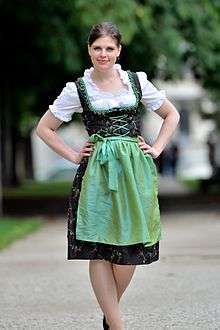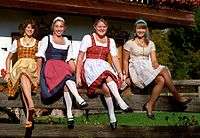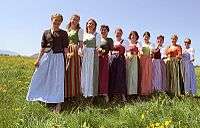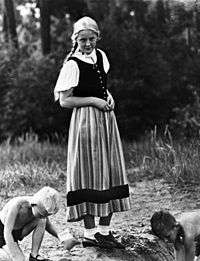Dirndl



A dirndl (German: [ˈdɪʁndl̩] (![]()
A dirndl skirt generally describes a light circular cut dress, gathered at the waist, that falls below the knee.[5][6]
Description
The dirndl consists of a bodice and skirt or a pinafore dress, a low-cut blouse with short puff sleeves, full skirt and apron.[7][8][9] While appearing to be simple and plain, a properly made modern dirndl may be quite expensive as it is tailored, and sometimes cut from costly hand-printed or silk fabrics.[4][8]
The winter style dirndl has heavy, warm skirts and aprons made of thick cotton, linen, velvet or wool, and long sleeves. The colors are usually rich and dark. The summer style is lighter and more revealing, has short sleeves, and is often made of lightweight cotton.
Accessories may include a long apron tied round the waist, a waistcoat or a wool shawl. In many regions, especially the Ausseerland, vibrantly colored, hand-printed silk scarfs and silk aprons are worn. Women often wear necklaces, earrings and brooches made of silver, the antlers of deer or even animals' teeth. For colder weather there are heavy dirndl coats in the same cut as the dresses, with a high neck and front buttons, thick mittens and wool hats.
Different styles were worn in different regions,[4] but they are now more universally generalized.[4]
Dirndl vs. Tracht and traditional folk costumes

The typical dirndl and folk costume varies from one region, or even village, to another. Folk costume has various details according to the place of origin and social status of the wearer. The modern dirndl is heavily stylized but clearly influenced by typical Bavarian costume. There is also a distinction between the typical dirndl (that is, a garment with an apron made of material with traditional patterns and embroidery) and rural domestic clothing, made from gray or colored linen, sometimes with leather bodice and trim.[10]
History

Origins
The dirndl originated as a more hardy form of the costume worn today: the uniform of Austrian domestic workers during the 19th century . Simple forms were also worn commonly by working women in plain colors or a simple check. The Austrian upper classes adopted the dirndl as high fashion in the 1870s, making it a highly fashionable and popular must-have item in the nation soon after.[10]
Both skirts and pinafore dresses with vest-shaped tank tops, cooking aprons and blouses were commonplace in Europe in the 17th and 18th centuries.[10]
The basic blouse/skirt/corset idea came from the eastern regions of the Swiss Alps, and was originally simple rural clothing. It became female Austrian servants' work clothes as well as Alpine peasant attire in the 18th century and exclusively servant’s work clothes in the 19th century.[10]
It appeared in its current state of decorative format and style in eastern Switzerland in the 1890s, and spread in the early 20th century[11] to the south of Germany, Austria, Liechtenstein,[10][11] South Tirol, Trentino and Valcanale Friuli.
Modern European usage
Dirndls and Landhausmode were abandoned for a while after World War II. While the wearing of the corresponding garments was scarcely popular in the 1970s, it has grown strongly since the 1990s.[10][12][13][13][14][15]
In the 21st century, fashion designers have adopted the dirndl, with varying results.[10][12][13][13] It has become a popular Upper Tyrol and Bavarian fashion[16][17] and regular party outfit during Oktoberfest.[18][19] .[20][21][22] There the Dirndl is more common with skirts ending more above the knee, bodice just reaching to below the breasts, and dirndl-blouses with deep neckline and bare shoulders.
In Switzerland, the dirndl is the official outfit for certain representations, events, cultural shows and singing old folk songs often involving yodeling.[11][23]
Today, dirndls vary from simple off-the-shelf styles to exquisitely crafted, very expensive models.[7][9][10]
Several versions and even disjointed dresses that are loosely based on the dirndl are known as Landhausmode (literally "country house style") dresses.[7][9] [24][25][26][27][28][29][30] The children's version is called Mädchenkleid (girl's dress).
These are closed-collar dirndls [31][26] and these are open-collar dirndls [32][33]
Germany and Austria have many manufacturers of the outfits. Both the open-collar and closed-collar versions are popular in those countries.
In Austria, and other parts of south central Europe, there are literally splashy events known as Dirndlspringen, in which people, overwhelmingly attractive young women, are judged by how well they dive from a diving board into a lake or a swimming pool while wearing the dirndl.
North American usage
Germans, Austrian, Swiss and Scandinavians people migrated to North America in the 19th century. Germans made a strong contribution to the gene pool of Montana, Minnesota, the Dakotas, Missouri, Wisconsin, New York City [34] and Chicago. The German American ethnic group (German: Deutschamerikaner) are their descendants in north America.[35][36] Beginning in 1920 and especially after World War II, many Danube Swabians migrated to the United States, Brazil, Canada, Mexico, Austria, Australia, and Argentina.[37]
Across the United States there are dozens of German-American cultural or heritage clubs, such as the Donauschwaben[38] heritage clubs.[34] In these clubs, members host events and festivals to preserve and/or celebrate their heritage with the surrounding communities. During these festivals, participants often dress in traditional outfits such as dirndls and lederhosen.
Name
In the South German dialects (Bairisch), Dirndl originally referred to a young woman or a girl, while the word Dirndlgewand referred to the dress.[39] Nowadays, Dirndl may equally refer to either a young woman or to the dress.[39] Dirndl is a diminutive form of the dated word Dirn(e) for "girl"; in the 20th century, Dirne (originally a euphemism) has also developed towards meaning "prostitute".[39] The word is Dirn in standardized German and Deern in Low Saxon.[39][1]
Dressing etiquette
The dirndl is mostly worn in Austria and Bavaria. It is used as an everyday dress primarily by older women in rural areas. Other women may wear it at formal occasions (much like a Scotsman wearing a kilt) and during certain traditional events. It is hugely popular also among young women at the time of a Volksfest, such as the Oktoberfest in Munich (and similar festivals),[19][20][21] although many women will only wear dirndl-style dresses, called Landhausmode, which may deviate in numerous ways and are often much cheaper.
In Austria and Bavaria, the dirndl may often be seen on women working in tourism-related businesses, and sometimes waitresses in traditional-style restaurants or beer gardens. It is also seen in these regions on women in the Volksmusik business.
There is an urban legend that claims the placement of the knot on the apron is an indicator of the woman's marital status.[22][40] In this story, which is not based in tradition, tying the sash on the woman's left side indicates that she is single, and a knot tied on the right means that she is married, engaged or otherwise not interested in dating.[41][22]
Films featuring women in dirndl costumes
Musical mentions of dirndls
The dirndl is mentioned in the song "Turn Around", composed in 1959 by Harry Belafonte, Alan Greene, and Malvina Reynolds. "Dirndls and petticoats, where have you gone?" This song was originally recorded by the Kingston Trio.
See also
References
- 1 2 3 NAME, YOUR. "Dirndl - German Dress Dirndl". German Choices.
- 1 2 </NAME, YOUR. "German Beer Maid Costume". German Choices.
- ↑ Ethnic Dress in the United States: A Cultural Encyclopedia, eds. Annette Lynch; Mitchell D. Strauss (Lanham, MD: Rowman & Littlefield, 2015), p. 100
- 1 2 3 4 "Archived copy". Archived from the original on 2015-04-12. Retrieved 2016-11-15.
- ↑ Watt, Alice (26 April 2012). "Dirndl Skirts". Elle. London. Retrieved 7 October 2013.
- ↑ Dacre, Karen (8 May 2012). "Spin out with springtime's dirndl skirt". London Evening Standard. London. Retrieved 7 October 2013.
- 1 2 3 "Oktoberfest Dirndl dress: the bow". Onesprime.de. Missing or empty
|url=(help);|access-date=requires|url=(help) - 1 2 "German Dirndl - an illustrated guide". Destination-munich.com. 2017-03-25. Retrieved 2017-04-04.
- 1 2 3 "How to wear a dirndl | The Lady & the Rose". Ladyandtherose.com. 2012-09-21. Retrieved 2017-04-04.
- 1 2 3 4 5 6 7 8 "Keine Angst vorm Dirndl - Mode & Kosmetik - derStandard.at › Lifestyle". Derstandard.at. Retrieved 2017-04-04.
- 1 2 3 Archived 2013-05-06 at the Wayback Machine.
- 1 2 "HauptNews Detail". Echoonline.at. 2013-10-24. Retrieved 2017-04-04.
- 1 2 3 4 "Von Dirndln, Trachten und Akademikerbällen - Kommentare der anderen - derStandard.at › Meinung". Derstandard.at. 2014-01-24. Retrieved 2017-04-04.
- ↑ NAME, YOUR. "Dirndl - German Dress Dirndl". German Choices.
- ↑ "Jedermann - Rockoper". Wolfgang Boehmer komposition arrangement libretto.
- ↑ DW (English) (10 September 2010). "The Dirndl Folk Dress - euromaxx" – via YouTube.
- ↑ "Perfektes Dirndl-Dekolleté: Die modischen Tricks für die Wiesn-Tracht". 25 September 2012 – via YouTube.
- ↑ "Tracht - Signora e la Moda".
- 1 2 Schmidt, Maximilian (1902). Meine Wanderung durch 70 Jahre. Zweiter Teil (in German). Reutlingen: Enßlin & Laiblin. pp. 247–260.
- 1 2 "Oktoberfest". Spaten. Retrieved 11 December 2013.
- 1 2 "10 Things you didn't know about Oktoberfest". Costume Crazy. Retrieved 7 September 2015.
- 1 2 3 "How To Wear a Traditional Bavarian Dirndl - The Lost Girls". www.lostgirlsworld.com.
- ↑ "What are the Swiss traditional clothes?".
- ↑ "Sommerdirndl". Sommerdirndl. Retrieved 2017-04-04.
- ↑
- 1 2 "Buy Heidi Red Dirndl Online | Germany | Ernst Licht, USA". Ernstlicht.com. Retrieved 2017-04-04.
- ↑ "Dirndl.com - Original Bavarian Oktoberfest Dirndl Dress and Lederhosen". Usa.dirndl.com. Retrieved 2017-04-04.
- ↑ "Children". Kerstins-landhausmode.com. Retrieved 2017-04-04.
- ↑ "Bavarian Superstore, Einkaufen wie Gott in Bayern". Bavarian-superstore.de (in German). Retrieved 2017-04-04.
- ↑ "Dirndl". Wiesnkoenig USA. Retrieved 2017-04-04.
- ↑ "Photographic image" (JPG). 4.bp.blogspot.com\accessdate=2017-04-04.
- ↑ "Photographic image" (JPG). 4.bp.blogspot.com\accessdate=2017-04-04.
- ↑ "Fashion Design: Fashion dirndl Dress". Amusingfashion.blogspot.co.uk. Retrieved 2017-04-04.
- 1 2 e.V., Deutsche Zentrale für Tourismus. "German Clubs across America".
- ↑ Aspera. "memoria.ro - bibliotecă digitală de istorie recentă".
- ↑ F, José Blanco; Hunt-Hurst, Patricia Kay; Lee, Heather Vaughan; Doering, Mary (23 November 2015). "Clothing and Fashion: American Fashion from Head to Toe [4 volumes]: American Fashion from Head to Toe". ABC-CLIO – via Google Books.
- ↑ "bibliotecă digitală de istorie recentă". Memoria.ro. Retrieved 2017-04-04.
- ↑ "Danube Swabians". Wikipedia. 2017-01-25.
- 1 2 3 4 Arten-Meyer, Angela (1 January 2011). "Munique e Arredores: Alemanha! Por que não?". Books on Demand – via Google Books.
- ↑ Horn, Heather. "You're Wearing Your Oktoberfest Dress Wrong". The Atlantic. Retrieved 2017-10-02.
- ↑ Stanek, Julia (18 September 2013). "The Dirndl Code: Expert Tips for a Rollicking Oktoberfest". Der Spiegel. Hamburg. Retrieved 7 October 2013.
Bibliography
- Gexi Tostmann: Das Dirndl (Alpenländische Tradition und Mode). Verlag Christian Brandstätter, Wien 1998
- Heide Hollmer, Kathrin Hollmer: Dirndl. Trends, Traditionen, Philosophie, Pop, Stil, Styling. Edition Ebersbach, Berlin 2011, ISBN 978-3-86915-043-7
- Daniela Müller: Alles Dirndl. Anton Pustet Verlag, Salzburg 2013, ISBN 978-3-7025-0693-3
- Elisabeth Wallnöfer: Geraubte Tradition. Wie die Nazis unsere Kultur verfälschten. Sankt Ulrich, Augsburg 2011, ISBN 3867441944
External links
| Look up Dirndl in Wiktionary, the free dictionary. |
| Wikimedia Commons has media related to Dirndl. |